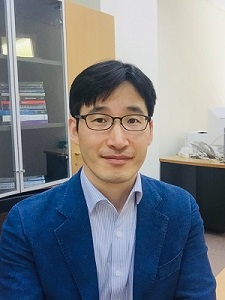
Principal investigator
Jeongmin Kim, PhD
Assistant Professor (조교수)
Department of Applied Bioengineering (응용 바이오 공학과)
Graduate School of Convergence Science and Technology (융합과학기술대학원)
Seoul National University (서울대학교)
Education
- (2016) PhD in Mechanical Engineering, UC Berkeley, USA
Major: MEMS/nano, Minor: Physics & Electrical Engineering
- (2006) MS in Mechanical Engineering, KAIST, Korea
- (2004) BS in Mechanical Engineering, Kyungpook National University, Korea
Employment
- (2020-present) Assistant Professor, Department of Applied Bioengineering, SNU GSCST, Korea
- (2022-2024) Affiliated Professor, Department of Intelligence and Information (지능정보융합학과), SNU GSCST, Korea
- (2019-2020) Postdoctoral Scholar, QB3 Institute & Dept. of Chemistry, UC Berkeley (Prof. Ke Xu lab)
- (2016-2019) Postdoctoral Scholar, Dept. of Mechanical Engineering, UC Berkeley (Prof. Xiang Zhang lab)
- (2012-2013) Grad Student Researcher, Materials Sciences Division, Lawrence Berkeley National Laboratory, USA
- (2006-2011) Engineer, Manufacturing Technology R&D Center (생산기술연구소), Samsung Electronics (삼성전자), Korea
Teaching
This course offers a detailed overview of optical microscopy used in biological, medical and industrial measurements. Topics include optical microscope theory, key microscope components and mechanics, and the principles of various modern optical microscopes including bright-field, phase, polarization, fluorescence, confocal, nonlinear, light-sheet, super-resolution microscopes (SIM, STED, PALM/STORM). This introductory course is aimed at both microscope users and developers and helps students leverage microscopy knowledge in their own research or later in industry.
생물학 및 의학 연구나 산업 측정 분야에서 핵심 도구인 광학 현미경법의 상세한 개요를 소개한다. 광학 현미경의 조명/결상 원리 및 성능, 광학/기계 핵심 요소품, 그리고 명시야, 위상, 편광, 형광, 공초점, 비선형, 광시트(light-sheet), 초고분해능 현미경(SIM, STED, PALM/STORM)을 포함한 다양한 종류의 현대 광학 현미경법을 다룬다. 본 교과목은 광학 현미경 이용자 또는 개발자를 대상으로 하며, 학생들이 현미경 지식을 자신의 연구나 차후에 산업 현장에서 활용하는 데 도움을 주는 것을 목표로 한다.
> 개설학기 (2학기): 2020, 2021, 2022, 2023, 2024, 2025년
This course introduces advanced optical imaging theory based on wave optics. Topics include derivation of paraxial imaging equations for partially coherent imaging systems, analysis of imaging systems in the spatial and frequency domains, and calculation of imaging point spread functions and transfer functions under optical aberration and/or spatial light modulation. Students also learn how to apply vectorial diffraction theory, considering polarization and non-paraxial propagation of light, to generalized optical systems. This course aims to help students acquire useful knowledge for research projects in the area of optical technology such as optical imaging, modern optical microscopy, optical tweezers, and optical data storage.
본 강의는 파동 광학에 기반한 광학 이미징 이론을 소개한다. 일반화된 이미징 시스템의 근축 결상 방정식을 유도하고 결상 특성을 공간 및 주파수 공간에서 해석하는 방법을 습득한다. 광학 수차 또는 공간 광변조가 있는 이미징 시스템의 점퍼짐함수 및 전달함수 계산법을 다룬다. 나아가 빛의 편광이나 비근축 전파를 고려하는 벡터 회절 이론을 일반화된 광학 시스템에 적용하는 방법을 소개한다. 본 강의에서는 광학 이미징, 현대 광학 현미경법, 광학 족집게, 광학 데이터 저장 등 광기술 분야의 다양한 연구 프로젝트 수행에 도움이 되는 지식 습득을 목표로 한다.
> 개설학기 (1학기): 2021, 2022, 2024년
This course introduces fluorescence imaging techniques that can achieve sub-100nm super-resolution in optical imaging by overcoming the physical resolution limit. Among the several super-resolution imaging methods that won the 2014 Nobel Prize in Chemistry, single molecule localization microscopy (SMLM, a.k.a. PALM or STORM) is covered in detail. Topics include imaging principles, microscope configuration, localization strategies, image reconstruction, technology development trends, and biological application studies, all of which can help students fully understand SMLM and use it in their research.
광학 이미징의 물리적인 해상도 한계를 뛰어넘어 100nm 이하의 초해상도를 달성할 수 있는 형광 이미징 기술을 소개한다. 본 과목에서는 2014년 노벨 화학상이 부여된 여러 초해상도 이미징 기술 중에서 해상도가 20nm 수준으로 가장 우수한 단분자 국소화 현미경법을 상세히 다룬다. 이미징 원리, 현미경 구성, 국소화 전략, 영상 복원, 기술 개발 동향, 바이오 응용연구 사례 등을 살펴봄으로써 초해상도 현미경 기술을 완전하게 이해하고 연구에 활용하는 것을 목표로 한다.
> 개설학기 (1학기): 2022, 2024년
In this course, students will learn the comprehensive process of research paper writing. The course aims to provide an in-depth understanding of each step from planning to submission, allowing students to write papers themselves and enhance their research paper writing skills through in-class discussion and collaboration.
본 강의에서는 연구논문 작성의 전반적인 과정을 학습한다. 논문의 기획부터 제출까지의 각 단계를 심층적으로 이해하며, 학생들이 직접 논문을 작성하고 작성 내용을 강의 시간에 서로 토의하면서 연구논문 작성 능력을 향상시키는 것을 목표로 한다.
– Week 1: Understanding the Research Paper Publication Process
– Week 2: Essential Preparations Before Writing a Research Paper
– Week 3: Structure of the Paper; Methods and Content for Each Section
– Week 4: Analysis and Review of Papers Published in Top Journals
– Week 5: Writing and Revising the Outline of the Paper
– Week 6: Techniques and Strategies for Writing and Editing in English
– Week 7: Plagiarism; Reuse/Permission of Materials; Citation and Attribution
– Week 8: Cover Letter Composition and Submission Experience
– Week 9: Introduction to Peer Review and Revision Processes; Author Response Letter Writing Method
– Week 10-11: Practical Writing and Discussion of Papers: Writing and Evaluation of the Outline
– Week 12-13: Practical Writing and Discussion of Papers: Manuscript Draft Writing and Evaluation
– Week 14-15: Practical Writing and Discussion of Papers: Completion and Evaluation of the Paper
> 개설학기 (2학기): 2023년
인공지능 기술을 활용한 바이오이미징 분야의 최신 연구 동향을 살펴본다. 매주 할당된 논문을 읽어와 함께 토론하며, 이를 통해 새로운 연구주제를 도출하는 것을 목표로 한다.
This course covers the latest research trends in the field of bio-imaging based on optical imaging and artificial intelligence technologies. Students are expected to read their assigned research papers in advance and discuss them in class. The course aims to derive new research project topics.
> 개설학기 (2학기): 2022년
응용바이오공학 개론
> 개설학기: 2021년 2학기, 2025년 1학기
응용바이오공학 세미나
> 개설학기: 2021년 1학기, 2025년 1학기
융합 프로젝트 설계
> 개설학기: 2020년 1학기
